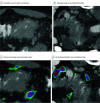Development and Validation of a Deep Learning Algorithm to Differentiate Colon Carcinoma From Acute Diverticulitis in Computed Tomography Images
- PMID: 36705919
- PMCID: PMC11984516
- DOI: 10.1001/jamanetworkopen.2022.53370
Development and Validation of a Deep Learning Algorithm to Differentiate Colon Carcinoma From Acute Diverticulitis in Computed Tomography Images
Abstract
Importance: Differentiating between malignant and benign etiology in large-bowel wall thickening on computed tomography (CT) images can be a challenging task. Artificial intelligence (AI) support systems can improve the diagnostic accuracy of radiologists, as shown for a variety of imaging tasks. Improvements in diagnostic performance, in particular the reduction of false-negative findings, may be useful in patient care.
Objective: To develop and evaluate a deep learning algorithm able to differentiate colon carcinoma (CC) and acute diverticulitis (AD) on CT images and analyze the impact of the AI-support system in a reader study.
Design, setting, and participants: In this diagnostic study, patients who underwent surgery between July 1, 2005, and October 1, 2020, for CC or AD were included. Three-dimensional (3-D) bounding boxes including the diseased bowel segment and surrounding mesentery were manually delineated and used to develop a 3-D convolutional neural network (CNN). A reader study with 10 observers of different experience levels was conducted. Readers were asked to classify the testing cohort under reading room conditions, first without and then with algorithmic support.
Main outcomes and measures: To evaluate the diagnostic performance, sensitivity, specificity, positive predictive value (PPV), and negative predictive value (NPV) were calculated for all readers and reader groups with and without AI support. Metrics were compared using the McNemar test and relative and absolute predictive value comparisons.
Results: A total of 585 patients (AD: n = 267, CC: n = 318; mean [SD] age, 63.2 [13.4] years; 341 men [58.3%]) were included. The 3-D CNN reached a sensitivity of 83.3% (95% CI, 70.0%-96.6%) and specificity of 86.6% (95% CI, 74.5%-98.8%) for the test set, compared with the mean reader sensitivity of 77.6% (95% CI, 72.9%-82.3%) and specificity of 81.6% (95% CI, 77.2%-86.1%). The combined group of readers improved significantly with AI support from a sensitivity of 77.6% to 85.6% (95% CI, 81.3%-89.3%; P < .001) and a specificity of 81.6% to 91.3% (95% CI, 88.1%-94.5%; P < .001). Artificial intelligence support significantly reduced the number of false-negative and false-positive findings (NPV from 78.5% to 86.4% and PPV from 80.9% to 90.8%; P < .001).
Conclusions and relevance: The findings of this study suggest that a deep learning model able to distinguish CC and AD in CT images as a support system may significantly improve the diagnostic performance of radiologists, which may improve patient care.
Conflict of interest statement
Figures



Comment in
-
Beyond the AJR: Artificial Intelligence Helps Radiologists to Improve Their Performance in Differentiating Colon Carcinoma From Acute Diverticulitis on CT.AJR Am J Roentgenol. 2023 Dec;221(6):849. doi: 10.2214/AJR.23.29466. Epub 2023 Apr 19. AJR Am J Roentgenol. 2023. PMID: 37073898 No abstract available.
Similar articles
-
Validation of a Deep Learning Algorithm for the Detection of Malignant Pulmonary Nodules in Chest Radiographs.JAMA Netw Open. 2020 Sep 1;3(9):e2017135. doi: 10.1001/jamanetworkopen.2020.17135. JAMA Netw Open. 2020. PMID: 32970157 Free PMC article.
-
Artificial intelligence stenosis diagnosis in coronary CTA: effect on the performance and consistency of readers with less cardiovascular experience.BMC Med Imaging. 2022 Feb 17;22(1):28. doi: 10.1186/s12880-022-00756-y. BMC Med Imaging. 2022. PMID: 35177029 Free PMC article.
-
Association of Artificial Intelligence-Aided Chest Radiograph Interpretation With Reader Performance and Efficiency.JAMA Netw Open. 2022 Aug 1;5(8):e2229289. doi: 10.1001/jamanetworkopen.2022.29289. JAMA Netw Open. 2022. PMID: 36044215 Free PMC article.
-
Diagnostic accuracy of an artificial intelligence algorithm versus radiologists for fracture detection on cervical spine CT.Eur Radiol. 2024 Aug;34(8):5041-5048. doi: 10.1007/s00330-023-10559-6. Epub 2024 Jan 11. Eur Radiol. 2024. PMID: 38206401
-
Comparison of Chest Radiograph Interpretations by Artificial Intelligence Algorithm vs Radiology Residents.JAMA Netw Open. 2020 Oct 1;3(10):e2022779. doi: 10.1001/jamanetworkopen.2020.22779. JAMA Netw Open. 2020. PMID: 33034642 Free PMC article.
Cited by
-
Revolutionizing gastroenterology and hepatology with artificial intelligence: From precision diagnosis to equitable healthcare through interdisciplinary practice.World J Gastroenterol. 2025 Jun 28;31(24):108021. doi: 10.3748/wjg.v31.i24.108021. World J Gastroenterol. 2025. PMID: 40599184 Free PMC article. Review.
-
Diverticulitis Is Associated with Increased Risk of Colon Cancer-A Nationwide Register-Based Cohort Study.J Clin Med. 2024 Apr 24;13(9):2503. doi: 10.3390/jcm13092503. J Clin Med. 2024. PMID: 38731032 Free PMC article.
-
Development and validation of automated three-dimensional convolutional neural network model for acute appendicitis diagnosis.Sci Rep. 2025 Mar 5;15(1):7711. doi: 10.1038/s41598-024-84348-6. Sci Rep. 2025. PMID: 40044743 Free PMC article.
-
Applications of Artificial Intelligence in Health Care Delivery.J Med Syst. 2023 Nov 17;47(1):121. doi: 10.1007/s10916-023-02018-y. J Med Syst. 2023. PMID: 37975946 Free PMC article.
-
Non-Invasive Tumor Budding Evaluation and Correlation with Treatment Response in Bladder Cancer: A Multi-Center Cohort Study.Adv Sci (Weinh). 2025 Jun;12(22):e2416161. doi: 10.1002/advs.202416161. Epub 2025 May 20. Adv Sci (Weinh). 2025. PMID: 40391846 Free PMC article.
References
Publication types
MeSH terms
LinkOut - more resources
Full Text Sources
Medical

